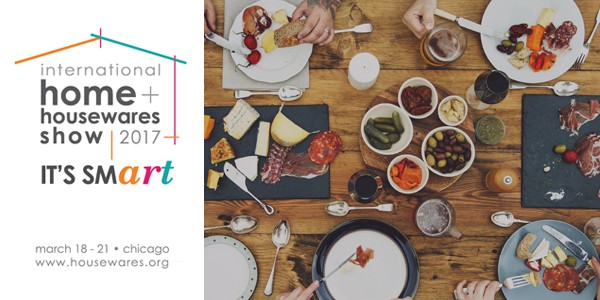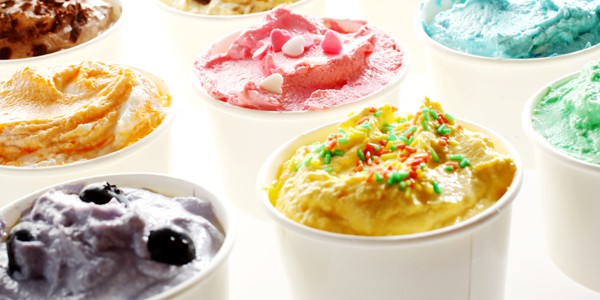A World of Opportunity: Ten Housewares Product Branding Trends You Need to Exploit
The Annual International Home + Housewares Show is almost here, taking place in Chicago, Illinois from March 18 – 21, 2017. It is the world’s largest housewares-only fair in the world and features more than 2,200 exhibitors from 6 continents, attracting more than 62,000 attendees from over 125 countries. It’s a barometer for the hottest consumer appliance and housewares product trends and the culmination of the efforts of some of the world’s leading manufacturers, entrepreneurs, and artisans. It is also a brief pause to reflect on the year’s achievements, celebrate, and begin to ask that tough question — “What’s Next?” It’s a great chance to start thinking about your product branding.
So What Is Next for Housewares in 2017?
We find ourselves in a society of material abundance, an abundance that has driven consumers to have astonishingly elevated expectations for everything they consume. Expectations that go beyond meeting the implicit qualities of excellent ease of use, to the explicit qualities of aesthetics and feel of a product or service. Expectations that now dictate that consumption needs to deliver personal advancement, meaning, and personal identity. Consumers no longer just want to have more, they want to be more. Your brand has to help people be the people they want to be and energize them to realize these idealized versions of themselves.
There is no doubt we are facing great changes, and at THRIVE we are all about change—what’s new, what’s next and more importantly, what it means. We work to understand the change and evolution in people’s behaviors, attitudes, and expectations so we can begin to determine which product strategies are the ones most likely to succeed by serving new and fundamental human needs in new ways.
So here is our look at the forces at play in the form of ten housewares trends that take the “long view” to present an opportunity set for the home and housewares industry in 2017 and beyond.
So jump in and unlock powerful new answers to the question “What will my customers want next?”
#1 Health & Wellness
Childhood obesity has more than tripled in the U.S. in the past 30 years. One-third of the U.S. adult population is obese, with 1/3 more qualifying as “overweight,” and weight-related health issues are on the rise globally.(1) As a result, consumers are looking for solutions. A growing number of families are purchasing organic foods (78% buy organic at least some of the time) (2). The proliferation (and normalization) of special diets from vegetarian and vegan to gluten, nut and sugar-free have a large quantity of us looking to tightly control food ingredients. And home cooking isn’t something only grandma does anymore. But it’s also hard to trust our authorities: let’s not forget the food safety scandals (Listeria, anyone? Salmonella? Yoga mat foam? Pink goo?) that fill social streams and nightly newscasts daily.
It all adds up to a larger trend toward pervasive wellness that pushes consumers of all ages to proactively manage their health—and demand items and foodstuffs seen as beneficial to the mind, body, and spirit. Catching this holistic wave requires some thought about what the aspirationally healthy want in their lives.
Opportunities
Seek balance – Address the negative health implications of an imbalanced and harried lifestyle.
Make natural choices creating premium propositions by combining elements of organic, natural and artisan credentials or by utilizing natural alternatives to conventional ingredients and elements.
Ensure outside matches inside – Package natural and organically produced products in sustainable containers to avoid an apparent ideological disconnect.
Promote “from scratch” – Enable simple, efficient preparation when it comes to food products, and create opportunities for consumers to grow their own, prepare from basic ingredients and save and preserve easily and efficiently.
#2 Evolving Landscapes
The world is shifting, changing rapidly as ethnic populations grow and gather their voices (and buying power) in the U.S., an expanding middle class erupts in emerging markets, migration toward cities continues, and household dynamics evolve far beyond the traditional “two biological parents and two-point-five children” model of the last century. Worldwide, the global middle class is expected to reach 5 billion by 2030 and represent 2/3 of global household spending by 2050 (compared to 1/3 today).(3) Product developers must take heed, and begin considering this increasingly diverse mix of varying cultural voices as they innovate.
The trend toward ethnic exploration is especially pertinent in the food world, as immigrant populations both introduce new cuisines to Americans and settle themselves into cooking the food of their homelands in their adoptive country. The result of all of this is a population as a whole that is both more accepting of unfamiliar choices and with more money in their pockets to purchase them.
Opportunities
License and leverage existing ethnic brands to acquire unique aesthetics, items, and methodologies.
Target brands and products to growing ethnic communities.
Embrace the influx of cultures by developing housewares products that specifically fit their unique needs, values, and ideals.
Think small, creating new housewares opportunities to grow, cook and entertain in space-constrained environments.
#3 More Work, Less Time
Americans are currently working longer hours than at any time since statistics have been kept (4), and the same technology that boosts productivity and keeps us persistently plugged into entertainment and family also backfires to keep the office emailing us well into off hours and vacation time. This translates to less time spent at home, or at the very least less time spent doing solely home-related things—as scrolling through one’s phone and cleaning one’s kitchen have become tasks that are hardly mutually exclusive.
Opportunities
Go simple; create foods that require little preparation and develop technologies that need less of a learning curve to offer maximum benefit.
Look into throwing it out, exploring disposables.
Consider on-the-go as the norm—time-constrained people have less opportunity for structured anything, from meals to snacks to me-time.
Make it easy, developing product and services that are both efficient and save time—such as easy-open packaging.
#4 Easy & Affordable
Many consumers are feeling squeezed: 83% of Americans note that the economy has caused them to become more cost-conscious, not just now, but for the long-run.(5) We’re entertaining more friends and family in our homes, spending more on eating in than eating out, growing our own food and relishing small luxuries and seasonal rituals rather than living it up all year long. As a whole, consumers are constantly on the lookout for ways to bargain hunt, from comparing prices online while in-store to batch-cooking and storing and choosing the store brand or private label as a matter of course rather than a short-term savings measure.
Opportunities
Make multi-function the mandate, creating versatile, multipurpose designs that reduce space, save money, and work hard for consumers.
Bundle for value, creating value-pack product offerings allow consumers to save by buying in bulk.
Support saving in the food arena, providing opportunities for long-term and large-scale food storage.
Prioritize quality. Studies find a clear preference among consumers for strategies that increase value by providing superior quality…even if the product ends up more expensive overall. Bonus: prices declined for several key housewares raw materials in 2015.(6)
#5 DIY Culture
You only have to watch a few moments of one of the several home improvement or cooking channels in your cable lineup to know that crafty, do-it-yourself culture is big in the U.S.A. Research bears out the trend: Although 46% of Americans are classified as classic DIYers, they account for 56% of shoppers.(7) We see a number of things colliding in this macro-trend, from retreat into hobbies for over-stressed workers and the proliferation of “top chef” inclinations made popular by media and travel, to a “made my way” mentality as people begin to create personalized solutions for themselves—things not previously thought appropriate to make at home.
Opportunities
Leverage celebrity to inspire novice hobbyists and chefs to demonstrate and encourage experimentation.
Provide the ingredients online making gourmet cooking and highly specialized hobby-ing available to those without local access.
Get the kids involved, by offering easy-to-use co-creation tools for little hands.
#6 Smart & Connected
The internet of things (IoT) has infiltrated the housewares industry in a huge way recently, with an explosion of internet connectivity for just about every type of product. Concurrently, mobile broadband penetration surpassed that of fixed, in-home broadband in 2011, creating new opportunities for consumers themselves to interact with one another, with brands, and gather information on both. This makes a proliferation of new and novel ways of connecting consumers with products and product with one another possible.
Opportunities
Embrace the digital revolution, giving consumers easy access to vital information about products and brands.
Harvest the feedback, and use insight gained in tweets, posts, and comments to create new, better products that meet consumer needs.
Understand that “identity” coincides with “informed” in that 61% of global consumers seek to make more informed choices based on knowledge (and approval) of product ingredients (particularly in the food industry).
#7 Experience & Indulgence
Today’s consumers want products to be more fun, indulgent, adventurous and exotic…i.e. more of an “experience.” New experiences are a reward to consumers—a little nugget of delight wrapped in a purchase. There’s a romanticism associated with the thoughts, feelings, senses and behaviors that surround a product or brand that go beyond the item’s physical form. The trappings feel personal, connective, and if we as humans love anything, it’s a good story—especially one we get to walk away and tell.
Opportunities
Design for the five senses, products that fuse sight with tactile, olfactory and aural elements to create truly sensual experiences.
Create an unboxing to remember; tactile, interactive packaging that allows the user to go beyond just seeing the product.
Mix sensorial with functional to further enhance product appeal in the housewares category
Entice experimentation by offering a steady stream of product variety in new flavors, scents, and colors.
#8 Individualism & Expression
Our purchasing decisions, especially items for the home and personal use, is in part an expression of selfhood—a declaration of individuality. As a result, consumers gravitate toward products and services that offer compelling image associations that match and transmit their own, ideal self-image. I am sophisticated. I am crafty. I am fun. I am ethical and conscientious. Also inherent in this trend is the idea that today, one can (and should) get something “just the way I want it.” To this end, empowered, individualistic buyers seek products that they can actively co-create, customize, and make theirs entirely.
Opportunities
Collaborate to co-create, designing products ripe for customization.
Get symbolic, design products with inherent meaning that resonate with your target audience.
Don’t overload with choice; exercise caution when offering too much possibility, as this can cause analysis paralysis (or decision overload; choose your favorite term).
#9 Sustainability & Ethics
Environmental responsibility has been a persistent trend for a while, but given our growing sense of globalism and the window on the world consumers have through their persistently connected devices, an evolved pattern surrounding sustainability and ethics has emerged. Call it mounting awareness and concern about the complexity and interdependence of shared social and environmental challenges on a global scale. Consumers are simply more plugged into the tone and timbre of environmental and cultural/social issues not only within their circle but in far-away places. Eighty-four percent of U.S. consumers are defined as “consumers who care,” and that caring manifests itself in a variety of purchasing patterns, from choosing sustainable laundry products to worrying about the scarcity of materials used to create items or the impact on the communities that produce them.
Opportunities
Visibly promote re-use, with sustainable and reusable packaging.
Elevate your CSR, creating marketing and advertising that communicates corporate sustainability initiatives.
Get credit, ensuring your brands get recognition for environmental efforts and transmit that to consumers.
#10 Comfort & Uncertainty
Modern life is stressful and uncertain. (See trend two. And four.) Consumers are combatting the trials of an increasingly complex existence by pursuing less complicated lifestyles—starting with the products they purchase. This trend plays out across a product’s core attributes, from ingredients or materials to messaging, packaging and at-the-shelf experience. Connectedly, high prices and continually stormy economic weather have restricted consumer spending, causing buyers to re-assess what value for money means to them.
Opportunities
Support “insperiences”, creating products that help consumers save time and effort when preparing to entertain at home.
Simplify, from packaging to messaging that clearly identifies product benefits to slimmer product mixes and reduced lines.
Elevate quality on the shelf. 62% of consumers are highly attentive to product packaging at the point of purchase as an indication of product quality.
According to the U.S. Bureau of Labor Statistics, the average U.S. household total expenditure increased 2.3% in 2015 versus 2014 (and we anticipate a similar upward swing for 2016 versus 2015 when reported). People are buying, seeking the new, the novel, the delightful, the functional. Looking for experience and exotic inspiration. Seeking comfort and products that ease their consciences. What will you develop that meets their gaze as they turn toward your industry with their wallets open?
References
1. Center for Disease Control (CDC)
2. Organic Trade Association
3. Wall Street Journal: June 22, 2012; Organization for Economic Cooperation & Development
4. ABC News
5. Time/Money American Financial Values Survey 2012
6. IHA 2016 State of the Industry Report
7. Packaged Facts, DIY Consumers in the USA

















